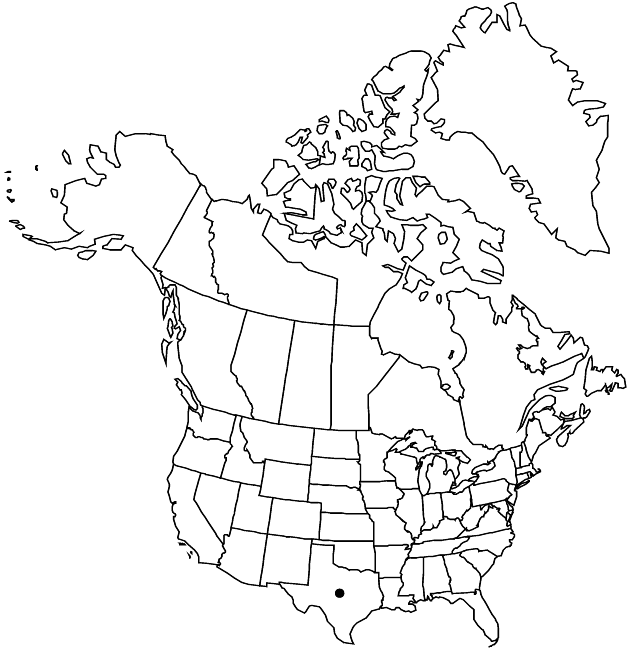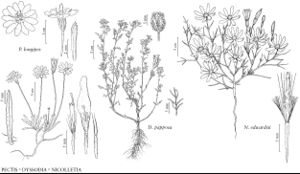Nicolletia edwardsii
Smithsonian Contr. Knowl. 3(5): 119. 1852.
Illustrated
Revision as of 22:31, 29 July 2020 by imported>Volume Importer
Annuals or perennials, 3–25 cm. Stems erect to spreading. Leaves 10–60 mm overall, lobes 3–5, linear to filiform, rachis widths hardly greater than lobe widths. Peduncles 5–30 mm. Calyculi of 4–6 bractlets 1–2 mm. Involucres turbinate to fusiform, 11–15 mm. Phyllaries 6–8, lanceolate. Ray-florets 7–9, laminae 7–16 × 3–6 mm. Disc-florets 15–25 (–50); corollas yellow, 7–8 mm. Cypselae 5–7 mm; pappi: bristles 3–5 mm, scales 5–7 mm. 2n = 20.
Phenology: Flowering mostly fall, following rains.
Habitat: Sandy, often calcareous or gypseous soils of fans, flats, or playas in desert scrub
Elevation: 800–1700 m
Distribution

Tex., Mexico (Chihuahua), Mexico (Coahuila), Mexico (San Luis Potosí), Mexico (Zacatecas)
Discussion
Selected References
None.
Lower Taxa
None.
... more about "Nicolletia edwardsii"
introrse +
connate +
herbaceous +
scarious +
absent +
hirsute +
papillate +
continuous +
decurrent +
lobed +
winged;ribbed;winged;ribbed +
deltate;lanceolate +
stigmatic +
barbellate +
alternating +
persistent +
subtending +
7;15 +
absent +
zygomorphic +
yellow +
monomorphic +
dimorphic +
puberulent +
clavate +
5mm;7mm +
staminate +
straight +
glabrous +
distinct +
proximal +
1;5 +
bisexual +
dispersed +
cylindric +
singly +
singly +
indeterminate +
Present +
surrounding +
turbinate;fusiform +
7mm;16mm +
3mm;6mm +
alternate +
cauline +
widths +
2-carpellate +
inferior +
attached +
anatropous +
persistent +
falling +
absent +
coroniform +
tough +
thick +
absent +
connate +
persistent +
distinct +
falling +
unequal +
Smithsonian Contr. Knowl. +
1852 +
hardly greater +
pistillate +
absent +
fertile +
epaleate +
pitted +
convex;conic +
fibrous +
exalbuminous +
modifed +
Illustrated +
alternate +
branched +
2-branched +
papillate +
Nicolletia edwardsii +
Nicolletia +
species +
cylindric +
much shorter +
much longer +
glaucous +
